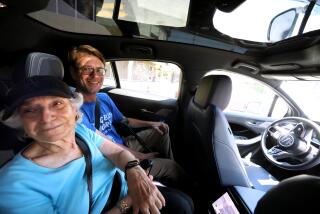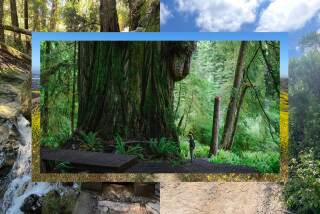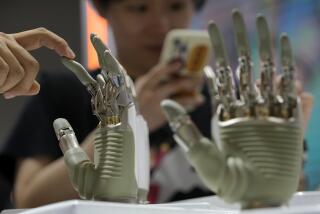Let’s Take a Walk to a New Frontier
- Share via
You are cordially invited to help advance the frontiers of science.
A group of researchers at UC Berkeley is working on methods of letting a whole bunch of people operate a remote system--like driving a robot on the moon--simultaneously. Resolving this issue becomes increasingly important as more people get access to the Internet, and cool new devices get connected to it.
For nearly a decade, scientists have used tools such as the Internet to share expensive hardware with people far away.
Today, researchers with networked computers can peer through an electron microscope, rummage through a museum’s collection, study the sky through a telescope and even pilot a remote-controlled submarine. All from the safety of their offices, which can be thousands of miles away from the instrument.
But with a couple of thousand people trying to take a spin on the device, each person gets only a few minutes running the gizmo before it’s the next person’s turn.
That’s where the experiments at Berkeley come in. Ken Goldberg and a crew of researchers are working on ways to let people work collaboratively in such situations, sharing time on a remote device to accomplish goals they all share. Hundreds, even thousands of people can cooperate on a project. At least that’s what the folks at Berkeley hope. They’re ready for a serious field test and they’re recruiting you to help.
On Wednesday, from noon to 12:30 p.m., you’ll be able to explore the highly secure Microlab Clean Room at Berkeley. It’s an experimental computer chip manufacturing facility stuffed with outrageously expensive state-of-the-art gear and overflowing with workplace hazards. It’s off-limits to the public; normally only people who work for the lab are allowed inside, and they have to wear those bunny suits to prevent contamination.
Participating in this experiment offers you the chance to “walk” through the lab with no danger. Just point your browser at https://teleactor.berkeley.edu/ and follow the instructions. You might want to go there a few days ahead of time to register.
Goldberg’s project, called the Tele-Actor, is using this column to recruit hundreds of participants to take part. The Berkeley project equips a human being--whom we’ll refer to as Rosie to make this explanation a little easier to follow--with a helmet containing a wireless camera and radio communications gear. Anybody logged into the system can see what the camera sees.
At various points in the exercise, technicians will offer participants a series of choices: turn left or turn right, for example. Everybody gets a vote, and votes can be changed until the tally is completed. You’ll be able to see how other people are voting, which might influence your own choice.
After the choice is decided by majority vote, the techs use the radio to tell Rosie what to do. Then another vote is taken and the exploration continues.
It sounds simple. And pretty mundane. But it’s actually terribly complicated and important stuff. Developing a system robust enough to handle thousands of people without crashing is hard.
This is the first attempt to test the setup with a large number of users. A recent test with two dozen participants went off without a hitch. If the system can successfully scale upward to handle thousands of users simultaneously, someday Rosie--or more likely a fairly sophisticated robot--will be able to explore delicate or dangerous environments for us.
Goldberg has a lot of irons in the fire. He’s an associate professor of industrial engineering, and electrical engineering and computer science. He’s also a gifted artist with a sly sense of humor. It’s no accident that this experiment turns a human being--Rosie--into your robotic slave. It’s a subtle comment on what technology may be doing to our society. Parts of the Tele-Actor research are aimed at exploring sociological questions as well as figuring out how to resolve technical problems.
Take voting as a means of resolving disputes, for example. It doesn’t always work well, as last year’s presidential election illustrated. But as Winston Churchill said of democracy: It’s the worst system we’ve got, except for all the others.
The Tele-Actor environment lets voters know how the election is proceeding, and participants can change their votes accordingly.
“In any society, there are a number of factors that influence our behavior,” Goldberg said. “This isn’t going to be any different. Everybody sees how everybody votes, and, theoretically, that should help everybody involved make the right choices. This is a place where you’re encouraged to vote early and vote often.”
This is a little cumbersome, but new technologies demand new ways of thinking. Eventually, the voting system might be weighted to let a Nobel Prize-winning chemist’s vote count more than a seventh-grader’s vote when it comes time to choose where to point the electron microscope.
Goldberg started setting up this experiment for the public back in August. Since the Sept. 11 attacks, he thinks development of systems like this is even more important.
“We’ve got new concerns about safety and security, especially in terms of traveling,” he said.
“This kind of technology is going to be widely used in the future, not just for deep sea exploration or outer space, but to let people safely explore every part of the world.”
So if you’ve got some spare time next Wednesday, why not help make a little history?






